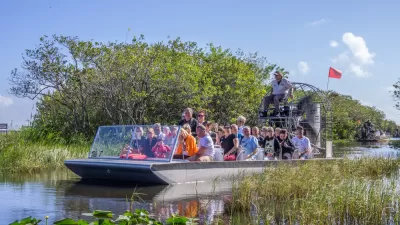The new Everglades strategy marks a “cultural shift” for the U.S. Army Corps of Engineers: rather than focusing primarily on flood control, the new plan seeks to balance the needs of the entire watershed, including limiting the spread of toxic algae.

The 730-square-mile Lake Okeechobee lies at the heart of the Florida Everglades. For decades, the watershed has been under threat, but an ambitious $21 billion federal and restoration effort seeks to change that, including a new management plan. Amy Green reports for Inside Climate News that a new plan, called the Lake Okeechobee System Operating Manual, was implemented earlier this month, and with it, a significant change in approach. Tim Gysan, LOSOM project manager for the U.S. Army Corps of Engineers told Green that, following a recent restoration of the 143-mile earthen dike around the lake, “the plan is designed to more equitably balance the needs of the watershed and stakeholders tied to it, rather than prioritizing flood control above all else.”
One particular concern is toxic algae, which has been a problem for Lake Okeechobee over the last several years and, when water is discharged during times of high water, the surrounding estuaries. “The noxious blooms have choked rivers, sullied beaches, sickened Floridians and left wildlife belly-up,” Green reports. With the warm temperatures brought by climate change, that problem is only expected to get worse. “Now that a $1.8 billion rehabilitation of the dike is complete, the Army Corps will have more flexibility to hold more water in the lake, reducing the harmful discharges.”
FULL STORY: New Lake Okeechobee Plan Aims for More Water for the Everglades, Less Toxic Algae

Alabama: Trump Terminates Settlements for Black Communities Harmed By Raw Sewage
Trump deemed the landmark civil rights agreement “illegal DEI and environmental justice policy.”

Planetizen Federal Action Tracker
A weekly monitor of how Trump’s orders and actions are impacting planners and planning in America.

The 120 Year Old Tiny Home Villages That Sheltered San Francisco’s Earthquake Refugees
More than a century ago, San Francisco mobilized to house thousands of residents displaced by the 1906 earthquake. Could their strategy offer a model for the present?

Ken Jennings Launches Transit Web Series
The Jeopardy champ wants you to ride public transit.

BLM To Rescind Public Lands Rule
The change will downgrade conservation, once again putting federal land at risk for mining and other extractive uses.

Indy Neighborhood Group Builds Temporary Multi-Use Path
Community members, aided in part by funding from the city, repurposed a vehicle lane to create a protected bike and pedestrian path for the summer season.
Urban Design for Planners 1: Software Tools
This six-course series explores essential urban design concepts using open source software and equips planners with the tools they need to participate fully in the urban design process.
Planning for Universal Design
Learn the tools for implementing Universal Design in planning regulations.
Clanton & Associates, Inc.
Jessamine County Fiscal Court
Institute for Housing and Urban Development Studies (IHS)
City of Grandview
Harvard GSD Executive Education
Toledo-Lucas County Plan Commissions
Salt Lake City
NYU Wagner Graduate School of Public Service





























